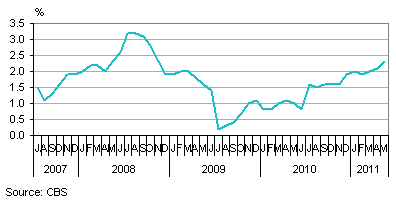Dutch inflation rate further up

The inflation rate in the Netherlands was 2.3 percent in May, i.e. 0.2 percentage points up on April. This is mainly due to higher energy prices. More expensive airline tickets and higher food prices also contributed to inflation. Inflation is defined as the increase in the consumer price index (CPI) compared to the same month in the previous year.
Housing, energy, water and transport costs contributed 0.6 and 0.5 percentage points respectively to inflation in May. Food and soft drinks and spending abroad contributed 0.3 and 0.2 percentage points respectively to inflation. Other goods and services hardly affected inflation.
The harmonised consumer price index (HICP) allows comparison between the inflation rates in the member states of the European Union (EU). According to the HICP method, Dutch inflation was 2.4 percent in May, an increase by 0.2 percentage points from the preceding month. Eurostat, the European statistical office, calculated an inflation rate of 2.7 percent in the eurozone in May, 0.1 percentage point lower than in April. The level of inflation in the eurozone is one of the main guidelines for the European Central Bank (ECB) to change or refrain from changing the interest rate. According to the ECB, prices in the eurozone are stable, if the inflation rate is close to 2 percent.
Dutch inflation

More figures can be found in dossier Business cycle.
For more information on Dutch inflation, see Statistics Netherlands’ online video on YouTube.